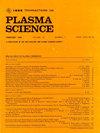由固态多绕组电感电压加法器驱动的纳秒脉冲大气压等离子体射流
IF 1.5
4区 物理与天体物理
Q3 PHYSICS, FLUIDS & PLASMAS
引用次数: 0
摘要
纳秒脉冲电场(nsPEFs)驱动的大气压等离子体射流(APPJ)由于其非热特性和丰富的活性氧和活性氮(RONS)而被研究和应用于等离子体医学领域。与传统的ns-APPJ纳秒脉冲发生器相比,电感电压加法器(IVA)能够通过电磁耦合实现高电压升压比,同时降低绝缘要求。在这项研究中,提出了一种具有可变绕组的固态纳秒IVA。该装置由10级耦合纳米晶铁芯组成,在容性负载上产生10khz重复脉冲。输出电压高达24 kV,升压比为53.3,匝比为1:3,负载电容器为400 pF。由于设计了磁开关,电容负载的半最大值最小全宽度为100 ns,下降沿窄。分析了寄生参数对脉冲性能的影响,讨论了脉冲规格和电路参数。此外,该发生器使用同轴针环电极驱动氩等离子体射流。应用发射光谱(OES)诊断APPJ。本研究提供了一种可行的nspef驱动等离子体设计。本文章由计算机程序翻译,如有差异,请以英文原文为准。
A Nanosecond Pulsed Atmospheric Pressure Plasma Jet Driven by a Solid-State Multiwinding Inductive Voltage Adder
Atmospheric pressure plasma jet (APPJ) driven by nanosecond pulsed electric fields (nsPEFs) have been investigated and employed in plasma medicine applications, owing to nonthermal characteristics and abundant reactive oxygen and nitrogen species (RONS). Compared with conventional nanosecond pulse generators for ns-APPJ, the inductive voltage adder (IVA) is capable of achieving high-voltage step-up ratios through electromagnetic coupling while simultaneously reducing insulation requirements. In this study, a solid-state nanosecond IVA with variable winding is proposed. The apparatus consists of ten stages coupled with nanocrystalline cores, producing 10-kHz repetitive pulses on capacitive loads. The output voltage is up to 24 kV with a step-up ratio of 53.3 and a turn ratio of 1:3 with a load capacitor of 400 pF. The minimum full-width at half-maximum (FWHM) on capacitive loads is 100 ns with a narrow falling edge owing to a designed magnetic switch. The influence of parasitic parameters on pulse performance is analyzed, and pulse specifications and circuit parameters are discussed. Furthermore, the generator is used to drive an argon plasma jet using a coaxial pin-ring electrode. The APPJ is diagnosed by optical emission spectroscopy (OES). This study provides a feasible design for nsPEF-driven plasmas.
求助全文
通过发布文献求助,成功后即可免费获取论文全文。
去求助
来源期刊

IEEE Transactions on Plasma Science
物理-物理:流体与等离子体
CiteScore
3.00
自引率
20.00%
发文量
538
审稿时长
3.8 months
期刊介绍:
The scope covers all aspects of the theory and application of plasma science. It includes the following areas: magnetohydrodynamics; thermionics and plasma diodes; basic plasma phenomena; gaseous electronics; microwave/plasma interaction; electron, ion, and plasma sources; space plasmas; intense electron and ion beams; laser-plasma interactions; plasma diagnostics; plasma chemistry and processing; solid-state plasmas; plasma heating; plasma for controlled fusion research; high energy density plasmas; industrial/commercial applications of plasma physics; plasma waves and instabilities; and high power microwave and submillimeter wave generation.
 求助内容:
求助内容: 应助结果提醒方式:
应助结果提醒方式:


